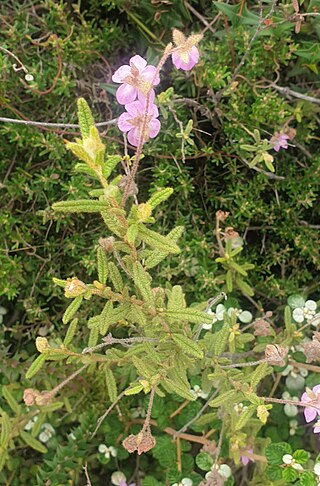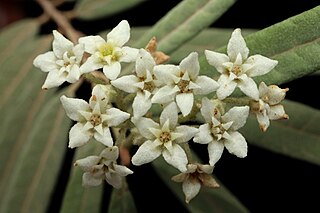
Olearia phlogopappa commonly known as the dusty daisy-bush or alpine daisy-bush is a species of flowering plant in the family Asteraceae that is commonly found in eastern New South Wales, Victoria and Tasmania. It is a small shrub with greyish-green foliage, daisy-like flowers in white, pink or mauve that can be seen from spring to late summer.

Seringia arborescens is a species of flowering plant in the family Malvaceae and is endemic to eastern Australia. It is an erect, spreading shrub or small tree with egg-shaped to lance-shaped leaves and cream-coloured or greenish-white flowers, usually in groups of 10 to 40.

Seringia nephrosperma, commonly known as free-carpel fire-bush, is a species of flowering plant in the mallow family and is endemic to northern Australia. It is an upright, suckering shrub with hairy new growth, usually oblong to lance-shaped leaves, and purple flowers arranged in groups of 5 to 25.

Seringia hillii is a species of flowering plant in the mallow family and is endemic to eastern Australia. It is a single-stemmed shrub with hairy new growth, egg-shaped leaves and usually mauve flowers arranged in groups of 2 to 9.

Seringia hermanniifolia, commonly known as crinkle-leaved firebush, is a species of flowering plant in the mallow family and is endemic to the south-west of Western Australia. It is a low-growing or prostrate, suckering shrub with hairy new growth, hairy, wavy, oblong to egg-shaped leaves and mauve to bluish flowers arranged in groups of 3 to 8.

Seringia velutina, commonly known as velvet firebush, is a species of flowering plant in the family Malvaceae family and is endemic to the south-west of Western Australia. It is a suckering shrub that sometimes forms dense colonies. Its leaves are narrowly elliptic to egg-shaped and it has 3 to 11 pale pink to purple flowers arranged in loose cymes.

Thomasia petalocalyx, commonly known as paper flower, is a species of flowering plant in the family Malvaceae and is endemic to southern Australia. It is a shrub with wrinkled, oblong to egg-shaped leaves and cup-shaped mauve flowers.

Prostanthera canaliculata is a species of flowering plant in the family Lamiaceae and is endemic to the south-west of Western Australia. It is a small, erect shrub with hairy branchlets, narrow egg-shaped to narrow elliptical leaves and pale blue or pale violet to white flowers with no markings.

Prostanthera hindii is a species of flowering plant in the family Lamiaceae and is endemic to the Central Tablelands of New South Wales. It is a small, erect shrub with densely hairy branches, egg-shaped leaves, and mauve flowers with deep mauve to dark purple colouration inside the petal tube.

Olearia paucidentata, the autumn scrub daisy, is a species of flowering plant in the family Asteraceae and is endemic to the south-west of Western Australia. It is a shrub with variably-shaped leaves, and white, mauve or blue and mauve or yellow, daisy-like inflorescences.
Olearia fluvialis is a species of flowering plant in the family Asteraceae and is endemic to inland areas of northern Western Australia. It is a shrub with scattered, narrowly egg-shaped leaves, and white or mauve and yellow, daisy-like inflorescences.
Epacris apsleyensis is a species of flowering plant in the heath family Ericaceae and is endemic to a small area of Tasmania. It is an erect shrub with hairy branchlets, lance-shaped to elliptic leaves and tube-shaped flowers with white petals.
Olearia lehmanniana is a species of flowering plant in the family Asteraceae and is endemic to inland areas of the south-west of Western Australia. It is a shrub with scattered elliptic or linear leaves that are densely hairy on the lower surface, and pale mauve, daisy-like inflorescences.
Hovea magnibractea, is a species of flowering plant in the family Fabaceae and is endemic to south-eastern Australia. It is a shrub with narrowly oblong to lorate (strap-shaped) leaves, and mauve and yellow, pea-like flowers.

Hovea similis is a species of flowering plant in the family Fabaceae and grows in New South Wales and Queensland. It is a shrub or small tree with hairy foliage and mauve and yellowish-green pea-like flowers.
Cryptandra triplex is a species of flowering plant in the family Rhamnaceae and is endemic to the north of the Northern Territory. It is a hairy shrub with narrowly elliptic to lance-shaped or egg-shaped leaves and white to cream-coloured or yellowish, tube-shaped flowers arranged singly or in groups of up to 5 in leaf axils, near the ends of branches.

Commersonia salviifolia is a species of flowering plant in the family Malvaceae and endemic to eastern Australia. It is a shrub with lance-shaped leaves and white flowers in clusters of 5 to 30.

Guichenotia micrantha, commonly known as small flowered guichenotia, is a species of flowering plant in the family Malvaceae and is endemic to the south-west of Western Australia. It is a low, compact shrub with linear to narrowly egg-shaped leaves and pink flowers in groups of three to six.
Seringia adenolasia is a species of flowering plant in the family Malvaceae and is endemic to northern Australia. It is a sticky, aromatic densely hairy shrub with egg-shaped to lance-shaped leaves sometimes with toothed edges, and creamy-pink or purple flowers, usually in groups of up to 5.

Seringia denticulata is a species of flowering plant in the family Malvaceae and is endemic to eastern Australia. It is a spindly shrub, densely covered with rust-coloured hairs, has egg-shaped to elliptic leaves and usually white flowers in groups of 6 to 10.














